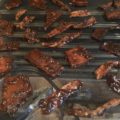Sausage… they say everyone loves it until they see how it’s made. When I saw how it was made commercially, I cringed. There’s a lot going on in commercial sausage-making and in the end, it’s jacked with a lot of things we can’t pronounce. Things that are probably worse than the original meat and fat content. But when I make it at home, it’s something of a small miracle. I realize not everyone is making sausage at home… but those of us who have the inclination to do things our own way. We can be creative about the things we add to our sausage and in the end, we know exactly what’s in it. That to me is the incentive to make it myself. Everything I eat is intentional. If I know it’s not good for me, I try not to put it in my body, or at worse, use it in moderation.

I don’t consider myself a carnivore and I’ll enjoy a vegetarian dish just as much as a dish with meat. I believe a diet of mostly plants is good for you but I also believe a diet absent of animal protein is not good for you. Most of us have wondered once or twice how our elders have lived long lives eating bacon for breakfast, and adding lard in their pie crusts. Could half the reason be that at the same time, they weren’t stuffing their face with processed foods? When they woke, they didn’t have toaster treats, baked goods and other things made of aspartame, MSG and HFCS. They had good ole’ fashioned eggs and bacon… then they went outside and worked it off during the day. Like them, our family tries to eat a diverse diet and in moderation.
So where does sausage fit into all of this? Sausage is something that is questionably bad for you. However, I submit that a little of everything that is unprocessed is OK for you… in moderation. Having been made by our own hand and knowing the ingredients is even greater.
So to the point of this article, I’ve made sausages from rabbit, chicken, venison, and most recently pork. I’ve smoked it, froze it fresh, and I’m just completing a curing/drying chamber to get into the wonderful world of Charcuterie. In my quest of trying to make great sausage, I failed the first few times, because I lacked knowing the basics. My sausages turned out dry and crumbly, or tough and with weird textures. However, since understanding a few key things and changing my process to accommodate, I’ve never looked back. I wish these requisites for good sausage were more clear to me from the beginning.
- Clean your tools and your area really good… we’re working with raw meat. It’s obvious, right?
- Everything needs to be kept COLD. Your meat, your spices, your water, the grinder attachments, the tray you will be grinding in to. Everything. Cold!
- Your meat and fat (previously cut into cubes) should be almost frozen. It’s just thawed enough for you to work with it, mix in your spices and grind it. But otherwise, as close to frozen as possible.
- I’ve always added my spices to the frozen meat and then added whatever cold liquids I’m using to distribute the seasonings before I ground it. Some believe you should add the seasonings first, grind it, then mix in the liquids to form the pellicle just before stuffing. I have experimented both ways and cannot say I’ve found a difference yet.
- The meat should come out of the grinder into a tray or bowl set in ice. I use aluminum trays that I pull out of my deep freeze. They stay cold enough for the short time it’s in the tray before I load it into my stuffer.
- While I’m waiting for the pellicle, I fry up a bit of the farce before I stuff it into the casings. If it needs any adjustments to the flavor, now, of course, is the time to do it. This is known as the quenelle test.

The reason for keeping everything cold is so that the fat doesn’t separate from the meat when cooked. If it does, it makes the sausage seem tougher… and have an unpleasant texture. Over-handling the meat doesn’t help it either. Working with it warm, or working it too much will cause what’s called “smear” and it signifies a “broken forcemeat” among sausage geeks. Many will say to give it to the dogs. I haven’t done that yet, but my first batches of sausage were certainly worthy of the dogs. From then on, I took keeping the meat cold very seriously. It does make a difference. Another deficit of my set-up was that my grinder dueled as my stuffer. I’d grind the meat through once, then I’d remove the dies and replace with the stuffing attachments to stuff into the casings. Again, the problem here was over-working the meat. Because it had to go through the auger again as it was stuffed into the casings, I believe it caused a broken forcemeat. I splurged for a separate stuffer, one where you would load the meat into the canister, and crank it down, effectively squirting the meat into the casings. You can see it in the pictures below. This also made a huge difference. Having the right tools for the job certainly helps, but also knowing a little of the science behind it will let you make a perfect sausage.
A quick note on casings. I prefer natural casings over any others. Casings are sold in hanks. A hank will stuff 100-125 lbs of sausage and they are pretty cheap, but not all butchers will sell them to you. I got in good with my local butcher and pick them up anytime I need them. While it may seem a little awkward handing slimy casings, once you have meat in it, there really is nothing better. They are easier to work with over the collagen casings or others that you have to soak before using. Natural casings are also more sheer, but strong enough to stand up to accidental over-stuffing, to a degree.
Oh, a quick note about clean-up. Don’t wash aluminum parts in your dishwasher. After years of washing my grinder parts by hand, just after I made the batch of sausage you see below, I decided to put the parts in the dishwasher only to my demise.









































Hi,
I just made the Chicken sausage with Basil and Tomatoes from Charcuterie (p. 123) Added ground chipotle pepper and cold smoked after stuffing. Beyond awesome! Kind of a smoked Chicken Andouille. Thx for the article on the curing chamber. That will be my next project as we are great fans of Bresaola. We make home cured pork belly bacon with Michigan Maple syrup, good black pepper corns, coriander seed, juniper berries and bay leaf. This is flavor you just can’t buy!
I agree Jim. Do you make your own syrup too? Happy New Year!
Hi Jason. We don’t make the maple syrup, but a co-workers family in Cadillac MI has the sugar bush. They make about 300 gallons a season. Happy and Safe New Year.